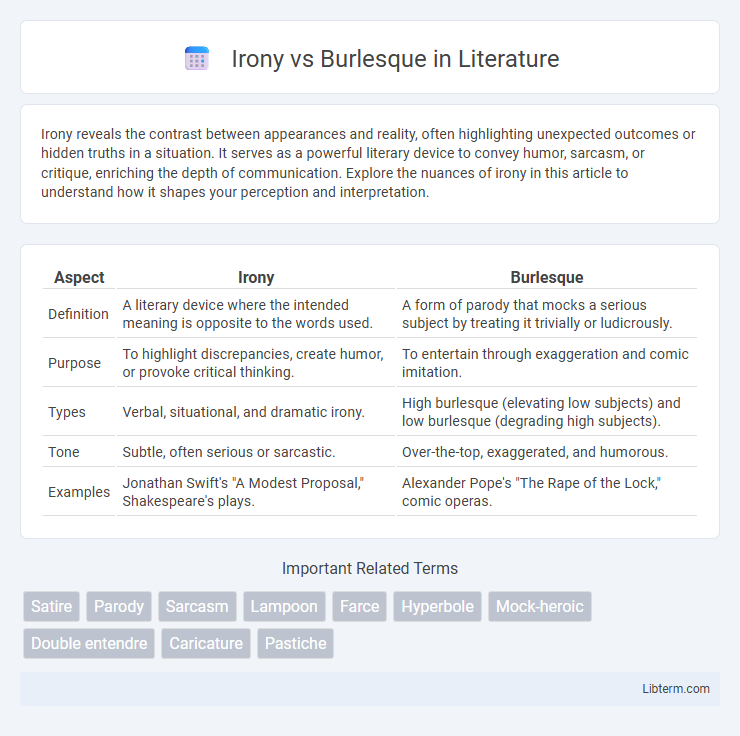Irony reveals the contrast between appearances and reality, often highlighting unexpected outcomes or hidden truths in a situation. It serves as a powerful literary device to convey humor, sarcasm, or critique, enriching the depth of communication. Explore the nuances of irony in this article to understand how it shapes your perception and interpretation.
Table of Comparison
| Aspect | Irony | Burlesque |
|---|---|---|
| Definition | A literary device where the intended meaning is opposite to the words used. | A form of parody that mocks a serious subject by treating it trivially or ludicrously. |
| Purpose | To highlight discrepancies, create humor, or provoke critical thinking. | To entertain through exaggeration and comic imitation. |
| Types | Verbal, situational, and dramatic irony. | High burlesque (elevating low subjects) and low burlesque (degrading high subjects). |
| Tone | Subtle, often serious or sarcastic. | Over-the-top, exaggerated, and humorous. |
| Examples | Jonathan Swift's "A Modest Proposal," Shakespeare's plays. | Alexander Pope's "The Rape of the Lock," comic operas. |
Understanding Irony: Definition and Types
Irony is a literary device where there is a contrast between expectations and reality, often highlighting the difference between appearance and underlying truth. The main types of irony include verbal irony, where what is said contrasts with what is meant; situational irony, involving a discrepancy between expected and actual outcomes; and dramatic irony, where the audience knows critical information that characters do not. Understanding these distinctions enhances the analysis of texts employing irony for humor, critique, or thematic depth.
What is Burlesque? Origins and Characteristics
Burlesque is a theatrical form that originated in the 17th century as a literary and dramatic genre characterized by exaggerated imitation and parody of serious works, often to create humorous or satirical effects. It evolved from Italian commedia dell'arte and British Victorian music hall traditions, incorporating bawdy humor, caricature, and slapstick performance. Key characteristics of burlesque include playful mimicry, risque costumes, dance routines, and a blend of comedy with sensuality, distinguishing it from irony by its overt theatrical exaggeration and spectacle.
Key Differences Between Irony and Burlesque
Irony centers on expressing meaning by using language that normally signifies the opposite, creating a contrast between expectation and reality, often to highlight contradictions or criticize. Burlesque employs exaggerated imitation or parody to mock or satirize a subject, focusing on humor through distortion and absurdity. The key difference lies in irony's reliance on subtle, often verbal contrast, while burlesque emphasizes overt, theatrical exaggeration.
Historical Evolution of Irony and Burlesque
Irony traces its historical evolution to classical Greek literature, where playwrights like Sophocles used it for dramatic effect, evolving through Roman satire and flourishing in Renaissance and Enlightenment literature as a tool for social critique. Burlesque emerged in the 17th century as a theatrical and literary form that exaggerated or parodied serious subjects for comedic effect, gaining prominence in Victorian-era performances that blended humor, dance, and music. Both irony and burlesque have remained influential in modern literature and entertainment, shaping narrative techniques and satire across various media.
Common Techniques in Irony
Irony commonly employs techniques such as verbal irony, where the intended meaning contrasts with the spoken words, situational irony, involving unexpected outcomes that defy logical expectations, and dramatic irony, where the audience possesses knowledge unknown to the characters. These methods rely heavily on contradiction and contrast to highlight disparities between appearance and reality. In comparison, burlesque uses exaggeration and parody to create humor, but irony's core techniques are centered on subtle or overt oppositions in meaning.
Signature Elements of Burlesque
Burlesque is characterized by exaggerated parody, physical humor, and theatrical extravagance, emphasizing elaborate costumes, slapstick comedy, and musical interludes that create a playful mockery of serious subjects. Unlike irony, which relies on subtle contradictions and implied meanings, burlesque showcases overt caricature and hyperbole to entertain and provoke laughter. Signature elements include grandiose set designs, risque dance routines, and direct audience engagement, making burlesque a dynamic fusion of satire and spectacle.
Irony in Literature and Everyday Language
Irony in literature involves expressing meaning through language that contrasts with the intended message, often highlighting contradictions or underlying truths. Common forms include verbal irony, where spoken words convey the opposite of their literal meaning, and situational irony, where outcomes defy expectations. In everyday language, irony frequently serves as a tool for humor, criticism, or social commentary by exposing discrepancies between appearance and reality.
Burlesque in Art, Theater, and Literature
Burlesque in art, theater, and literature serves as a satirical form that exaggerates or distorts subjects for comedic or critical effect, often lampooning social norms and cultural practices. Unlike irony, which relies on subtle contrast between expectation and reality, burlesque employs overt caricature and parody to provoke laughter and reflection. Its roots in theatrical tradition are evident in performances that combine music, dance, and exaggerated gestures, influencing contemporary literature and visual arts by challenging conventions through humor and mimicry.
How Irony and Burlesque Shape Audience Perception
Irony shapes audience perception by creating a contrast between expectations and reality, often leading to a deeper understanding of the underlying message through subtle humor or sarcasm. Burlesque transforms audience perception by exaggerating and parodying subjects, provoking amusement while highlighting absurdities in a more overt and theatrical manner. Together, irony invites reflective engagement, whereas burlesque encourages laughter through hyperbolic representation.
Contemporary Examples: Irony vs Burlesque in Modern Media
Modern media often employs irony to create contrast between expectations and reality, such as in the TV series "BoJack Horseman," where characters' actions reveal deeper societal critiques. Burlesque, meanwhile, exaggerates and parodies genres or subjects, evident in films like "Scary Movie," which lampoons horror tropes through comedic distortion. Both techniques serve to critique culture, but irony relies on subtle contradiction, while burlesque emphasizes overt mimicry and exaggeration.
Irony Infographic

 libterm.com
libterm.com